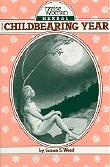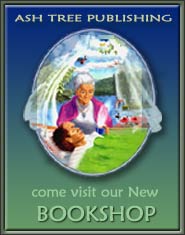HERBAL PHARMACY
Picking and Drying Herbs
by Susun Weed
In your herbal pharmacy you transform fresh and dried plants into herbal medicines. Learning to identify and use the common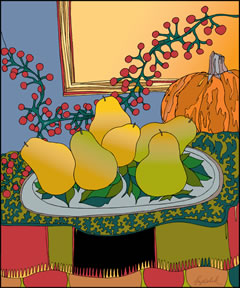 plants around you is easy and exciting, beneficial and safe.Making your own medicines saves you money if you follow the Wise Woman tradition of using local herbs, free for the taking.
plants around you is easy and exciting, beneficial and safe.Making your own medicines saves you money if you follow the Wise Woman tradition of using local herbs, free for the taking.
Even one day's work in field, forest, and kitchen can provide you with many years' worth of medicines.When you make your own, you know for sure what's in it, where it came from, when and how it was harvested, and how fresh and potent it is.
Dried herbs are best for the infusions recommended in this book. Stock your herbal pharmacy with your own foraged or cultivated dried herbs; expand your resources and experiment with new herbs by buying dried herbs from reputable sources.
Fresh herbs are best for the tinctures and oils recommended in this book. If you can't make your own, buy from sources who wildcraft or grow their own herbs to use fresh in preparations.
Whether you buy or make your own medicines, remember, herbal remedies may not work or may work incorrectly if they aren't prepared correctly. Read this chapter carefully; it contains easy to follow instructions for every remedy and preparation mentioned in this book [Wise Woman Herbal for the Childbearing Year].
Picking Herbs
When you have positively identified the plant you wish to use, center yourself by sitting next to the herb in silence. Take several deep breaths. Feel the earth under you, connecting you to all the plants. Listen to the sounds and songs all around you. Can you hear the song of your herb?
If you are picking only one plant, ask that plant to give you its power. Tell it how you intend to use it. If you are harvesting many plants, look for a grandmother plant. Ask her permission to use her grandchildren. Visualize clearly how you intend to use the plants.
Make an offering of corn or tobacco, a coin or love to the plants. Sing with them. Talk with them if you feel moved to do so. Thank the earth and begin your gathering.
Take care to preserve and contribute to the well-being of the plant community. Take no more than half of the annuals or biennials, no more than a third of the perennials. Walk gently and with balance.
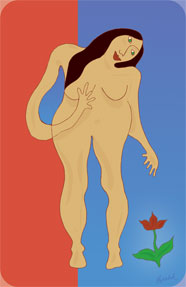 Harvest plants when the energy you want is most concentrated. Roots store energy in the form of sugar, starch, and medicinal alkaloids throughout the cold or dormant season; pick them when above ground growth of the plant has died back. Leaves process energy to nourish roots and flowers; pick them at their most lush, before flowers have formed, after all dew has dried, and before the day's heat wilts them. Flowers are fragile, pollen-filled, joyous; harvest them in full bloom, before seeds form, and before bees visit them. Seeds are durable, but likely to shatter and disperse if left on the plant too long; harvest seeds when still green and before insects invade. Barks (inner barks and root barks) may be harvested at any time but are thought to be most potent in spring and fall. Look carefully at the plant you wish to pick and you will see where the energy is highest; let this guide your harvesting.
Harvest plants when the energy you want is most concentrated. Roots store energy in the form of sugar, starch, and medicinal alkaloids throughout the cold or dormant season; pick them when above ground growth of the plant has died back. Leaves process energy to nourish roots and flowers; pick them at their most lush, before flowers have formed, after all dew has dried, and before the day's heat wilts them. Flowers are fragile, pollen-filled, joyous; harvest them in full bloom, before seeds form, and before bees visit them. Seeds are durable, but likely to shatter and disperse if left on the plant too long; harvest seeds when still green and before insects invade. Barks (inner barks and root barks) may be harvested at any time but are thought to be most potent in spring and fall. Look carefully at the plant you wish to pick and you will see where the energy is highest; let this guide your harvesting.
Deal with your harvest immediately. Allowing the cut plants to lie about dissipates their vital energies, encourages mold and fermentation, and results in poor quality preparations. If you intend to eat your harvest, refrigerate the plants, or wash and cook them and sit down and eat. If you intend to make a tincture or oil, cover the herbs with alcohol or oil as soon as possible; don't refrigerate them. If you intend to dry the herbs, it is vital to lay them out or tie them up as soon after harvest as possible.
Drying Herbs
To dry herbs and maintain their color, fragrance, taste, energy, and medicinal potency, you need only:
° Pick when there is no moisture on the plant and do not wash the plant (roots are the exception).
° Dry the herbs immediately after picking, in small bunches or spread out so parts don't touch.
° Dry them in a dark and well ventilated area.
° Take down the herbs and store in paper bags as soon as they are crisply dried. If insect invasions force you to store dried herbs in glass or plastic, air-dry them, then dry in paper bags for another two weeks before sealing in tight containers.
° Keep the herbs as whole, cool, and dark as possible during storage. Under optimum storage conditions, well-dried volatile, delicate herbs last about six months; roots and barks maintain potency for six or more years.
Green Blessings.
Susun Weed

Botany and Wildcrafting for Herbalists DVD
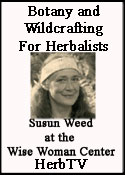 Botany for Herbalists DVD
Botany for Herbalists DVD
Susun Weed takes you on a walk with her apprentices and her goats across her land at the Wise Woman Center. In this DVD she explains the Latin naming system devised by Swedish botanist Carl Linnaeus in the 1700's. Each herb has a family and a genus that it belongs to and a species that is its name. She explains the Tree of Life, flowering and non-flowering plants, and the reproductive cycle of flowering plants and herbs. She also teaches you about indentifying and harvesting herbs; and differentiates between annuals, biennials and perennials. As Susun says: “Weave yourself into the Wise Woman web. Join me in reclaiming herbal medicine as people’s medicine. Loving green blessings from me to you.”
Time: 1 hr, 12 min, 43 sec.
Produced in 2009 by HerbTV Studio
Order Botany for Herbalists DVD in our Bookshop
Elements of Herbalism: Harvesting - 2 CD set

Susun Weed lecture
Elements of Herbalism: Harvesting (Green Nations '08) Ethical wildcrafting and harvesting instructions for all plant parts, including leaves, roots, flowers, seeds, and bark of all annuals, bienneials, and perrenials.
2 CD set
(CD1/54 min & CD2/65 min)
Order Elements of Herbalism CD: Harvesting in our Bookshop




